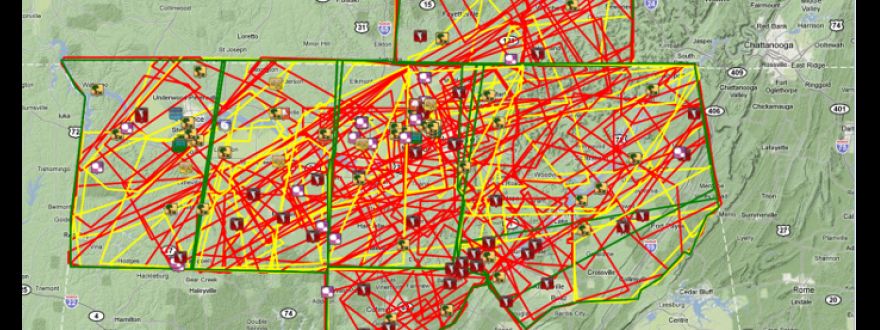
I'm grateful for that alert I got on my phone when the tornado came through Fort Walton last week. I'm sure many others saw that alert and heeded its warning while others carried on what they were doing. Tornadoes happen on every continent (except Antarctica for some reason) but the majority happen in the American midwest from Texas to Ohio. It has something to do with the geography of warm southern waters and the cool jetstream leaving the Rockies, but we end with nearly 1200 tornadoes per year in the United States while Florida averages 66 a year.
My sister was living in Huntsville Alabama in 2011 when a terrible string of tornadoes came through. She and her four girls tell the story of how they huddled in the bathtub in a dark room for hours while the town was hit with four EF4 and three EF5 tornadoes, along with 32 smaller ones. Hundreds of lives were lost with entire neighborhoods destroyed, in all 62 tornadoes tracked across Alabama in an 18 hour period. Many lives were saved becasue of the warnings issued, allowing people to seek shelter, and directing recovery efforts to those hit the hardest.
For some amazing graphics and tons more information about this extraordinary event, check out this NOAA page devoted to it. The picture included above shows the tracks left by the storms, somehow managing to avoid my sisters house and making our family very grateful.
I'm not trying to downplay the tornado that came through our area this past week, any storm like this is dangerous and we are grateful the damage was minimal. The National Weather Service is sending a team to determine the tornado's strength, so no word yet on how it compares to past storms.
How do tornadoes form and what to watch for? It all starts with
Warm and Cool air
This spring weather has been a bit weird and tornadoes like weird. It stayed cool longer than normal and the first ingredient for tornadoes is warm moist air meeting cool dry air, and you'll remember we’ve had both lately. This air collides and causes horizontal rolling air. Combine this with a large thunderstorm and you get a Supercell.
This is what they are talking about with a Tornado Watch is issued. Now how is a watch different from a warning?
Watch vs Warning
A tornado watch is issued when conditions are suitable for a tornado to develop. They are usually issued hours in advance over a large area when a thunderstorm has characteristics of a supercell, ie air spinning inside it. Many storms this size produce lots of lightning, heavy rain and possibly hail. They aren't really sure yet what causes this spinning to turn vertical but when it does, little extensions of clouds emerge beneath the main storm. If they extend far enough to touch the ground, you get a tornado.
A tornado warning means a tornado has been spotted in your area. These alerts are issued minutes in advance over a small area. This is the alert we got on our phones and they aren't kidding, except maybe for that guy who told everyone in Hawaii nukes were on the way. Pranksters make bad weathermen.
Take a look back at the included photo of the storms in Alabama. See how neatly the stroms' paths fit into the boxes? Those boxes were the areas issued Warnings
What to do in a Tornado Watch
Stay alert and review the plan. If you dont have a plan, it's time to make a plan. A Watch means you have time and it's possible no storm will even develop. Watch for a Warning to be issued, and if it is it's time to put the plan into action. The plan can be simple but everyone in the home or business should be aware of it ahead of time. For more information about forming a plan, come by our office for a free Emergency Preparedness Guide.
Unless you have a bunker, the safest room in a house is usually in the center of the bottom floor with no windows. Most tornadoes are small and short lived with winds between 60-100 mph (EF0 or EF1). There was an EF3 in Pensacola in 2016 Many houses around here, especially on 30A, have storm rated windows up to 150 mph. The record longest tornado path was cut by the Tri-State tornado on March 18, 1925. It was on the ground for 3 hours and covered 219 miles in Illinois, Indiana, and Missouri. That of course is worst case scenario.
Peak season is April through June, the nationwide average path length is 5 miles and 165 yards wide. Around here they typically come in off the water (the way this one did), so the closer to the water you are the more likely you'll be to have a brush with a tornado at some point or another.
How well can they predict tornadoes now and how much warning do we actually have?
Ground based radar can't see them develop but satellites can, so we are making progress in efforts to predict and track storms. The reality is there will not be much warning and predicting tornadoes more than a few minutes before they happen is currently out of our reach. Make preparations now on where you will find shelter because a few minutes can make all the difference in the world.
The views expressed here are the opinion of the author and do not attempt to make any recommendation for insurance coverage. Eligibility is determined by the insurance carrier and not all applicants will qualify. Please contact your licensed insurance agent regarding your area's coverage and eligibility.







